| Nov 28 |
Archive for November, 2011Defeating the baddie with a well-sharpened rereadingI’ve now defeated baddies in four different novels. But that adds up to a lot more than four baddies. I’m counting right now, and if you include minions, packs of slightly untrustworthy wolves, and creatures up to no good making the lives of my goodies more difficult, I think I’ve come up with ways of destroying, defeating, evading or embarrassing at least 13 different baddies or groups of baddies. But when I started writing each book I didn’t know how I was how going to defeat any of them. I almost think that would be cheating, to have a baddie that I already knew how I was going to deal with. Because the goodies don’t know. They don’t have any idea what they are going to do, and I like it like that. They are scared and nervous and confused and often don’t know what the baddie’s agenda is, or even all their powers. Usually, as the writer, I do at least have that information before them. I can build the baddie to be as nasty or strong or clever or tricky as I like. But I certainly DON’T deliberately build in any weaknesses. I don’t have some kind of washing machine style built-in obsolescence. Because I want a real baddie not a cardboard pushover. When I’m writing, there comes a point about two thirds or three quarters of the way through the book when I start to see how the final battle or confrontation is going to happen. I call it the endgame, and when it slowly starts to form in my mind, that’s usually when I begin to see how to defeat the baddie. In the book I’m writing now, the fourth First Aid for Fairies book, I knew who had to defeat the baddie (you’ll see who and I’m sure you’ll understand why when you read the book), I was starting to see where it had to happen, and once Helen made a very daft mistake, I even knew why it had to happen. But I didn’t know how. No idea. I have this great big clever powerful highly-armed baddie. And no idea how to defeat him. This is ok. This has always happened to me. I’m starting to assume that it always will and that it’s just part of how I write. But this time it was getting a bit worrying. I am now on chapter 26 of the book. There will only be about 30 chapters. I’m very nearly at the endgame. And last week, I had no idea how it was going to end. Not an inkling, not a tiny little clue. I’ve never taken so long to see how to defeat the baddie before… I was starting to wonder if this particular monster was too much for me. But then I went back and reread the rest of the manuscript. I read the first trap, the four quests, the dragon riddles. I was actually rereading it to check I hadn’t left any silly loose ends. But while I was rereading, I suddenly realised how to defeat the baddie! It was there all along. It was in what I had already written. Everything I needed was already there! This is why I have complete faith in the writing process, because whenever I have a big problem to solve, the answer is usually there in the small details of what I’ve already written. A Scottish writer called Janet Paisley said pretty much the same thing at a workshop I went to years ago at the Edinburgh Book Festival: if you have a plot problem the answer is probably in what you’ve already written. I’m pretty sure that doesn’t hold true for plot problems in the first two paragraphs, but if you’ve got thousands of words and a good knowledge of your characters, then you probably already have all the tools and weapons you need to defeat that baddie! So, now I know what we’re going to do. Fabled beasts, let’s go get him! |
| Nov 23 |
Archive for November, 2011The joy of picture booksCute is pretty much a swearword in our house these days, both my children having grown out of thinking “well, aren’t you cute!” is a compliment. But there are now two really cute kids around again, because I’ve seen all the finished pictures for my next picture book: Orange Juice Peas. And the Floris 2012 catalogue is out, so I can show it to you, or the cover, at least. The two kids in Orange Juice Peas, Jessie and Ben, are SO CUTE. And that’s not an insult, it’s just a fact! It was a joy watching both of them come to life in sketches, roughs and final pictures by the wonderful illustrator Lizzie Wells. That’s the best thing about picture books. I have the idea, I write the words and I create the story, but the illustrator brings the characters to life. It’s nerve-wracking meeting my creations for the first time in a picture, just in case they look somehow wrong. There are lots of ways for a character to look right, not just one way, but there are just as many ways for them to look wrong. But this time it’s fine, lots more than fine, because Lizzie has brought Jessie and Ben (and their cat, their babysitter, and their dad’s hairy legs) to life wonderfully. So picture books really are teamwork. Novels are teamwork too, with the editor an essential part towards the end of the process. But picture books are more obviously teamwork. And if you get a great illustrator, who tells the story in expressions and movement, then the writer can back off a bit and take some words out again. I sometimes get asked ‘Do you have your own illustrator?’ No, I don’t. I don’t keep an artist in the cupboard, or the fridge, or under the desk. But I think the question means: are all my books illustrated by the same person? And no, they’re not. Sometimes I think it would be nice to have a recognisable style to all my picture books, so that people could say, ‘oh, that’s the new Lari Don and x book.’ But it’s also good to have exactly the right artist for each book, because they are all different stories, with different characters, in different realities. Gabby Grant’s funny cheeky polite pictures were perfect for The Big Bottom Hunt, Nicola O’Byrne’s simple panoramic style was ideal for How to Make a Heron Happy and now that I’ve seen them, I know that Lizzie Wells’ colour, energy and CUTE faces are wonderful for Orange Juice Peas. I wonder who will illustrate my next story? No idea. But for now, I’ll just smile at the cover of Orange Juice Peas: |
| Nov 16 |
Archive for November, 2011The weirdest photo call I’ve ever doneThe winner of the Set the Scene competition, to suggest a location for the fourth and final First Aid for Fairies book, is: EMILY WRIGHT! She suggested the gorgeous Traquair House and (this is what won it for her) Traquair House Maze…. Today I met Emily at the maze to present her prize, with various photographers and journalists there taking pictures and interviewing her. Emily was fabulous. Really calm, patient and great at answering questions. But it was one of the weirdest photo calls I’ve ever done… Because we were presenting the prize in the maze. So a nice man showed my publisher the quick way to the middle, then he went off and left us. But all the journalists and photographers turned up at different times, and once we’d taken the first journalist into the middle, all the press who arrived later got lost on their way in! We were in the middle getting our photo taken (which is my least favourite bit of being an author) and we kept hearing footsteps wandering around a few hedges away, so we’d have to shout: “Are you here for the photocall? Are you lost? Do you need us to come and find you?” The lady from Borders TV managed to fit herself and her camera through a little hole in the hedge, which was very impressive. So it was quite spooky and very dramatic doing an interview in the middle of these high hedges, with lost people all around, and with my publisher shouting instructions like “left, no the next left, oh you’ve gone too far, go back…” Then everyone else went away, leaving me and Emily in the middle of the maze on our own, so they could get a nice picture from high up on the terrace of Traquair House. They left us. In the maze. On our own. And I wasn’t the one who’d been shown the way in or out! So, has it taken me til this evening to escape? No, it’s ok – they came to get us out eventually, but the feeling of being stuck in there was pretty good practice for imagining Helen and Yann trapped in there… which I should probably go off and write now! So well done Emily, and well done the brilliant runners up, from Inverkip, Tain, Ullapool and Falkirk. And well done too to the other 250 kids who entered. It was very hard to choose a winner, because all the ideas were fabulous. I wish I could write a book about every single one of them. But I can’t, or not this year anyway! But you all have great imaginations and you all know your suggested locations really well, so why you don’t set an adventure there yourself and let me see what you come up with! Here are some photos of me and Emily at the maze! And please notice, I managed this whole blog without using the word “amazing” at any point. I wonder if the local press will be as be restrained. |
| Nov 13 |
Archive for November, 2011Letting readers influence the storyMy writing is not a solitary occupation. I do imagine and scribble and type the stories on my own. But I often do it in busy noisy sociable places. Not sitting-in-a-café-nibbling-cake or gazing-at-inspiring-art sort of places. Even though that was what I’d hoped a writer’s life was like, I never seem to have time! No, I do lots of writing on trains and buses on the way to book festivals or school visits. And I do a lot of writing outside my kids’ afterschool classes (I was writing a story about dancing giants outside my daughter’s ballet class recently, and I swear the cute little girls in the hall were making more noise than the giants in my head). So I’m often writing surrounded by people and noise. And I like to involve other people in my writing. I work closely with various editors, and they sometimes point out plot problems and suggest solutions. (I then come up with my own completely different solutions, just to show that I’m my own person, but I always fix the problem.) But all writers have to work with their editors. I often involve other people too. My own kids have been involved in brainstorming titles and character names (often at bus stops.) And I sometimes read whatever I’ve been writing on the train to whatever children I’m visiting: What do you think? I’ll ask. And I will listen to what they say, often scribbling it down on the ms. But what I’m really looking for is whether they gasp at the right bits… (because then I know it’s working!) I’ve had research help from readers too: a class in Inverkip Primary did lots of selkie research for Storm Singing. But this year, I’ve taken involving others in my writing a bit further. This year my publishers Floris ran a competition for readers to suggest a location for the fourth and final First Aid book. (I had already used most of the bits of Scotland that I knew, and I was hoping for new and exciting ideas.) So we offered as the prize the promise that whatever location won would definitely be in the finished book. That promise was a HUGE risk! What if everyone had suggested impossible, boring or clichéd places? What if I’d committed myself to setting the book in a supermarket car park? I was putting the whole future of the book into the hands of the readers. But I needn’t have worried. We got hundreds of ideas, and they were all FANTASTIC! I could write a lifetime’s worth of adventures based on all those wonderful locations. So what location won? I’m not telling. Not yet. We’ll announce it on Wednesday. So watch this space! |
| Nov 01 |
Archive for November, 2011Asking the landscape some questionsI had an all-day adventure at the end of last week, researching a hill for the first quest in the Fourth First Aid book. When I go to a location, I don’t just turn up thinking: oooh, I hope this is a pretty place! I put a lot of work into picking potential locations, so I will have read books of local legends, googled the area, and bought a really detailed Ordnance Survey map. If I can find so much out without leaving my desk, why do I bother to go? Well, I realised when I was preparing for my trip on Thursday (no, I’m not telling you where I went – that would give too much away!) that I wanted to ask the landscape some questions. Like I was interviewing it, for the job of being my location. My questions on Thursday included: Are there sheep nearby? Is there somewhere to park a dragon? And could a horse get up that hill? The answers aren’t always what I’d expect. From the map, I thought a nearby quarry would be a good place to park a dragon. But when I got there, there was a farmhouse really close, which put me off poking about (I don’t like wandering into people’s gardens, especially if they have big dogs) and if it put me off, it would certainly be too close to human habitation for Sapphire. So I had to keep asking the landscape: is there ANYWHERE to park a dragon round here? But it isn’t just parking spaces. I need to find the right places for escapes, fights, magic and chases. However, I never know exactly what I want to happen in a story , and I’m always open to the landscape inspiring me, so I have to look very hard at what’s there, not just at what I expected to be there. I can take a very long time to walk up a hill when I’m researching, because I have to stop walking every time I want to scribble something, or else I might put my foot down a rabbit hole, or slip on some sheep jobbie. I found a lot of sheep jobbie on Thursday. I wonder if it might come in handy. As a weapon? Who knows… And I try to go on the journey with the characters, seeing it the way they would. For example, a barbed wire fence along the path didn’t bother Helen or me, but it really bothered Lee, because faeries don’t like iron. So I had to see the landscape not just through my eyes, but theirs too. So – that’s how I interview a landscape. Not the sanest thing to do on a sunny Thursday in October, but lots of fun, very muddy, and essential to the first quest. Now, where am I going for the second quest? |
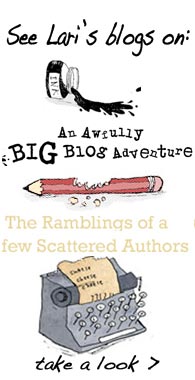
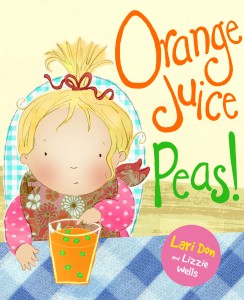
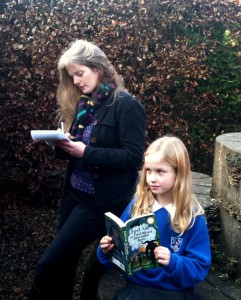
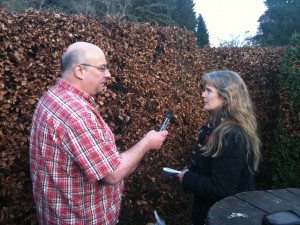
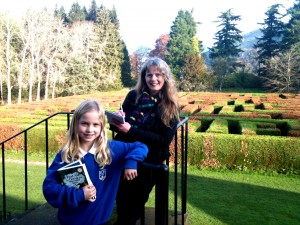
Recent Comments